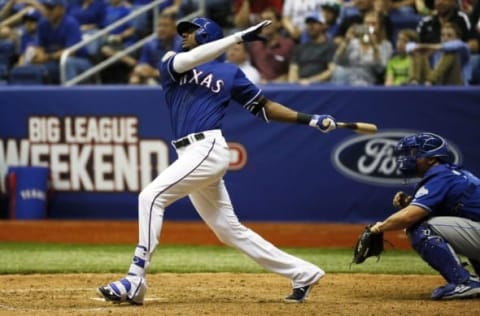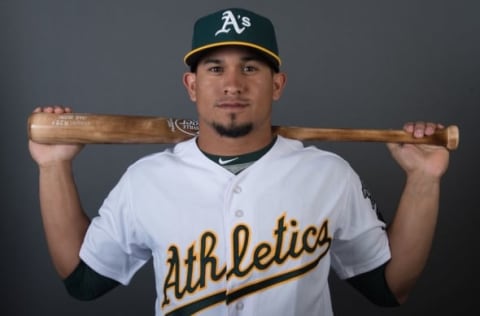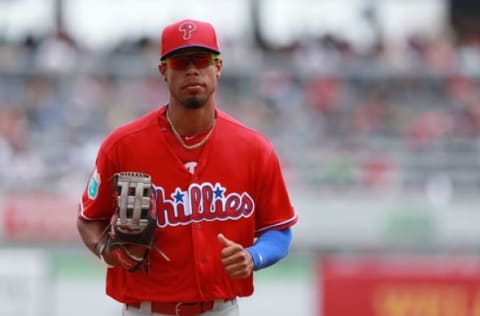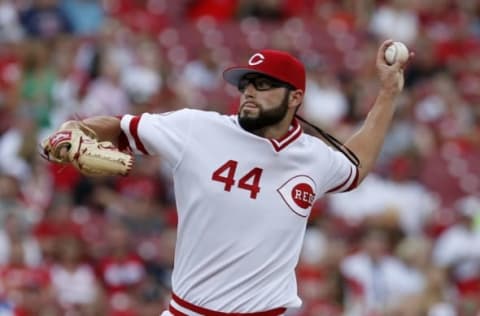Baseball’s 50 Top Prospects: 30-21


Who are the top prospects in all the land?
It’s that time of the summer. Minor League All-Star games are completed or soon to be completed, the Futures Game rosters have been announced, and the short-season leagues are all now playing, so all teams that will be playing this season have played at this point.
You’ll see a number of various publications come out with their top prospect lists over the next few months, and each of them bring a different perspective. I’m going to put forth a top 50 today in groups of 10 throughout the day.
A few things, I won’t be putting any players drafted in the 2016 draft in this list. There is simply too much yet to be known about those players to grade them against players with professional experience at this point.
I think you’ll enjoy the list, and I’d love to hear any comments about where you disagree or where a player could have been rated differently. Thanks for the read!
Next: #30 & #29

30. Lewis Brinson, OF, Texas Rangers
Coming into this season, Brinson had a lot of helium, and interestingly, a lot of consensus, as Baseball America ranked him #16, MLB.com #16, and Baseball Prospectus #15. Much of this was predicated on a “changed” swing in 2015 that resulted in drastically reduced strikeout rates and better contact. The issue is that the “old” swing is back again this season.
Brinson is a guy who absolutely oozes natural talent. He has incredible speed, and he has light tower power to go along with it. The issue for him has always been the swing and miss and the lack of contact in his long swing that has quite a bit of moving parts in it. Last year, it required Brinson to really perfect all the pieces of the swing, and, to his credit, he held that “perfect” swing for nearly the entire season, including the Arizona Fall League, but you started to see the wheels come off in the Puerto Rican Winter League.
Brinson is a true center fielder who can track down balls very well, and the Rangers love him out in center field, and they could very well live with the lower average and strikeouts, knowing they’d get the power and speed along with the defense, but currently, he’s hitting .219 with a .273 OBP in AA, and that could be hard to play, even with those other aspects.
29. Josh Hader, LHP, Milwaukee Brewers
Only MLB.com even had Hader on their top 100 list, but to their credit, they had him a ways up the list at #61. Hader’s looked like arguably the best pitcher in the entire minor leagues this season for the Brewers between their AA and AAA teams. So far, between the two levels, Hader has totaled a 1.87 ERA, 1.13 WHIP, and 30/99 BB/K ratio over 77 innings.
That’s not a misprint – 99 punch outs in 77 innings. Hader’s been part of two July deadline deals, but he’s seemingly found a home in Milwaukee. His build, arm angle, and long limbs resemble White Sox ace Chris Sale, and obviously the results track similarly this year. Due to his lower arm angle, he’s struggled at times to get on top of his off-speed pitches, but he’s doing that much better this year, especially with the slider. His fastball reaches the upper 90s in short bursts and sits 93-96 in game.
I was talking with a scout that’s seen Hader up close a few times and has been in the game for a while. He stopped me cold as I was asking about Hader specifics, and he said all I needed to know – “Ben, if
was 6’3 instead of 6’10, this is what he’d be”. My own viewing had Hader a top 40 guy for me, but that comment moved him up quite a bit for me.
Next: #28 & #27

28. Franklin Barreto, SS, Oakland Athletics
The A’s and Billy Beane took a lot of heat when they traded away Josh Donaldson before the 2015 season for what looked like a low-A prospect and two average pitchability type arms. Barreto is that low-A prospect, and the A’s have to be very pleased with what he’s become.
Barretto flashed speed at low-A in the Blue Jays system in 2014, stealing 29 bases, then flashed power last season for the A’s at high-A where he hit 13 home runs and 22 doubles over 90 games. This year, he’s offering both, with 7 home runs and 16 stolen bases in 74 games.
Barretto was ranked #35 by Baseball America coming into the 2016 season, #23 by MLB.com, and #26 by Baseball Prospectus. He has his this point in my ranking in spite of putting together the power and speed due to a nearly 3/1 strikeout to walk ratio this season along with his defensive struggles that have always been present forcing a move to second base, which could allow him to have more value in Oakland, which loves their players to be able to play multiple positions, but the fact that his defense was rough enough at shortstop to warrant the move is concerning.
He is still 20 years old, however, and he’s playing at AA, so he has plenty of time to mature as a hitter and develop some of those skills in the field to make better use of his tools.
27. Eloy Jimenez, OF, Chicago Cubs
The Cubs made Jimenez a priority in the 2013 international market, blowing through their budget to get the #1 rated prospect in that year’s class, spending a reported $2.8 million. To say their investment has paid off would be a drastic understatement.
Jimenez is the type of guy who catches your eye immediately due to his physicality. He’s listed at 6’4 and 205 pounds, and there may not be an ounce of fat on the frame (and he may be more like 215-225!). Then you realize that he won’t turn 20 until well after the season has been completed, and it’s even more impressive to consider how mature his body looks already.
He hit well for short-season Eugene last season, going .284/.328/.418 with 7 home runs in 250 plate appearances, but no one was prepared for what was coming this year. In 300 plate appearances, he’s hit .341/.378/.548 with 26 doubles and 10 home runs. He’s even stolen five bases. Now, the bad news…he’s walked in just 5.7 percent of his plate appearances and struck out in 22.1 percent of his plate appearances. In all seriousness, I’m not worried about the strikeout rate by itself, as 22 percent is not a terrible ratio, but the 5.7 percent walk rate is tremendously low.
Whether that low walk rate is driven by the tremendous success he’s having when making contact, so he’s just swinging away, or if he’s still working on his pitch recognition, or some level of combination of both, that does seem to be the real flaw left to his offensive game. He does profile as a left fielder as he doesn’t have a great arm, but he does track balls well enough to handle left field very well.
Next: #26 & #25

26. Nick Williams, OF, Philadelphia Phillies
Williams was selected in the 2nd round out of high school in Texas in 2012 by the Rangers. He’s always flashed incredible athleticism, but he also flashed ridiculous strikeout rates with a seeming allergy to taking a walk before last season, when he posted a very respectable 35/97 BB/K rate over 515 plate appearances in AA between the Rangers and Phillies organization. The increased patience paid off with results at the plate, as Williams posted his highest batting average and on base and his second highest slugging percentage of his minor league career, going .303/.354/.491 with 17 home runs, 13 steals and 6 triples.
This improvement led to Williams shooting up prospect rankings. Baseball America slotted him in at #27, MLB.com was more conservative at #64, and Baseball Prospectus ranked him #25. So this ranking seems like a stagnation or even a step backward when you consider graduations off of the list for those who have lost rookie eligibility.
That would be because, frankly, it is. In moving to AAA Lehigh Valley for Philadelphia, Williams has reverted back to his old habits, sporting a 17/74 BB/K ratio in 291 plate appearances. Sure he’s got a .288/.331/.461 line with 7 home runs and 5 stolen bases, but that strikeout to walk rate scares me when he hits a slump.
Williams is still 22, and the Phillies aren’t competing any time soon, so it’s wise for Williams to get as much time as he can at AAA to work on his patience and his eye at the plate, but history tells us that he may be part of one of the worst organizations to teach such a skill to a player (
, anyone?).
25. Ozzie Albies, SS/2B, Atlanta Braves
Outside of Fangraphs’ Kiley McDaniels (who is now employed by the Braves), no one was really big on Albies coming into the 2015 season. He was an under heralded, smallish shortstop from Curacao, which is an island the Braves have traditionally done very well in, but still, he wasn’t a guy who had the eye of national scouts. By midseason, that had changed, and Albies was the #1 prospect in the entire system. He hit .310/.368/.404 for Rome at 18 years old with 8 triples and 21 doubles, stealing 29 bases. While he didn’t hit a ball out of the park, he showed enough raw power to believe that he could add that as well.
Prospect rankings caught on to Albies, with Baseball America ranking him #63, MLB.com ranked him #29, and Baseball Prospectus ranked him #37. The Braves made a big splash trade over the offseason to acquire Dansby Swanson, and the question became who would be the long-term shortstop, Swanson or Albies. In spring training, Albies was the guy who really impressed the most, leading to him being placed at AA Mississippi while Swanson was placed at high-A Carolina to begin the season.
Mississippi went very well, and he earned a promotion before May rolled around to AAA, which is incredible as Albies is still 19 years old. Albies hit a wall in Gwinnett, however, especially defensively. When Erick Aybar came through Gwinnett on a rehab assignment, Albies moved over to second base, and suddenly the bat and the glove both took off. He profiles offensively very similar to Jose Altuve, and you’ve seen it ever since.
The Braves recently sent him back down to AA Mississippi so he and Swanson could begin playing together with Albies at 2B and Swanson at SS. In their first game together, Albies went 3-5 in the leadoff spot, and Swanson went 4-5 from the #3 spot in the lineup, and they looked extremely good in the field together, so Albies could be something special to watch with Mississippi now that he’s comfortable at 2B.
Next: #24 & #23

24. Bradley Zimmer, OF, Cleveland Indians
Zimmer was selected with the 21st overall selection in the 2014 draft out of college at the University of San Francisco. He came in with a very high defensive rating along with a reputation for power and speed. He did exactly that in 2014 in low-A, but that didn’t really get him on the prospect lists. In 2015, however, he really hit big between high-A and AA, going .273/.368/.446 with 16 home runs and 44 steals while playing excellent defense. He was then all over the prospect lists, rated #31 by Baseball America, #26 by MLB.com, and #23 by Baseball Prospectus.
This season, his lower-graded hit tool has started to show itself after he’d been able to put up solid batting averages thus far in his career. Zimmer’s bat path is not ideal for generating consistent contact, and while he can drive balls he gets a hold on, he has a lot of moving parts in the swing that leads him open to issues with low batting averages and lots of swing and miss in his game. So far this season, he’s hit .237/.362/.477 with 12 home runs and 27 stolen bases. While his strikeout rate is at 29.6 percent, and that’s too high for sure, he has added nearly 5 percent to his walk rate, walking at 14 percent, which is a very high ratio.
Zimmer’s elite defense is absolutely present in center field, but I am worried about the swing becoming an issue as he gets to the majors, which is my biggest hang up that keeps him here rather than a few spots higher.
23. Cody Reed, LHP, Cincinnati Reds
Reed was the 2nd round pick of the Royals in 2013, and he’d flown under the radar of many of their other prospects until he was part of the Johnny Cueto deal last summer, when people started to take notice of Reed. Coming into the season, Baseball America ranked him at #34, MLB.com had him at #66, and Baseball Prospectus ranked him #47.
This year he moved to Louisville, and frankly, he moved past the control issues he’d had early in his career and simply dominated. Before being promoted to Cincinnati, he had a 3.20 ERA with a 1.18 WHIP and 17/63 BB/K over 64 2/3 innings for AAA Louisville in his first exposure to AAA. On top of that, his pure stuff had taken a step forward.
His fastball that had ranged from 91-97 and touched 99 previously now sat consistent in the 93-95 range with very good late life, and he was still able to dial up the upper 90s when he needed to put a hitter away. His slider is absolutely ridiculous, sitting around 85-88, but the movement is absolutely knee-buckling. The big improvement has been in his change up, and while the change doesn’t carry a ton of movement, he’s worked hard to get that change to mirror the fastball the entire way to the plate, and hitters expecting the velocity of the fastball are seeing a change that often runs 12-15 MPH slower than his fastball with good location, and without the break of his fastball, which actually plays into the effectiveness of the change.
Reed has a very repeatable delivery, if possibly a lower arm slot than you’d like for long-term arm health, but he does well in his delivery utilizing his legs and not putting pure stress on his arm. He will be given every chance with Cincy this season, and he should be fun to see.
Next: #22 & #21

22. Rafael Devers, 3B, Boston Red Sox
I’ll be flat honest here. I just don’t get it. I don’t get what Devers is. His talent in batting practice is evident. When he runs the bases, you’d think he’s got ridiculous speed that’d translate. Then you look at his stat line, and he sits at .233/.298/.335.
Coming into the season, Devers was rated very high by Baseball America (#18), MLB.com (#17), and Baseball Prospectus (#35), but interestingly, I’ve heard from both Baseball America podcasts and MLB.com podcasts this year that they’ve been disappointed in their viewings in Devers, so I’m not the only one who’s been less than overwhelmed by his performance this year at high-A.
Obviously, this all takes into account that Devers is 19 years old at high-A, and he does still play elite level defense at third base with an absolute cannon for an arm. I’m impressed by Devers running the bases, though he’s only stolen 7 of 11 attempts on the season, which you would think would be better with his raw speed.
All in all, I can see the raw tools, but I would be very surprised if the Red Sox move him forward in the system without a very strong second-half showing.
21. Brendan Rodgers, SS, Colorado Rockies
Rodgers was the #3 overall selection in the 2015 draft, and many considered him to have the highest ceiling of any player in the draft. He came out and hit okay, but not outstanding for the Colorado Pioneer League team in Grand Junction, going .273/.340/.420. That led to some wide disparity in rankings, as Baseball America had Rodgers #40, MLB.com had him #12, and Baseball Prospectus had him #20.
The Rockies moved Rodgers to A-ball Asheville this year, and he started the year on fire, launching home runs left and right. He’s cooled off from his hot start, but his overall numbers have been very good, .289/.357/.485 with 10 home runs and 17 doubles in 267 plate appearances. One thing I’ve noted is that he’s played 14 games at second base, but part of that is what I’d consider a poor decision by the Rockies as they’ve put two legit shortstop prospects at the same level in Rodgers and 19 year-old Venezuelan Carlos Herrera, who’s a defensive wizard.
Rodgers certainly can stay at short, so the games at second base shouldn’t worry dynasty league owners or prospect fans by any means. The biggest thing I’m watching is Rodgers’ walk rate, which is currently at 7.5 percent. That’s not unplayable by any means, especially for a 19 year-old in A-ball, but it’s something he needs to improve on as he moves forward.
Next: 2016 Draft Winners and Losers